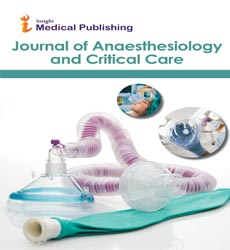Clinical Manifestation and Interactions of Regional Anesthesia in COVID-19 Disease
Thomas Edwards*
Department of Anaesthesia, Chelsea and Westminster Hospital NHS Foundation Trust, London, UK
- *Corresponding Author:
- Thomas Edwards
Department of Anaesthesia, Chelsea and Westminster Hospital NHS Foundation Trust, London, UK
E-mail: thomasedwards02@yahoo.com
Received Date: November 21, 2021; Accepted Date: December 06, 2021; Published Date:December 13, 2021
Citation: Edwards T (2021) Clinical Manifestation and Interactions of Regional Anesthesia in COVID-19 Disease. J Anaesthesiol Crit Car. Vol.4 No.2:07
Commentary
The extreme intense respiratory disorder Covid SARS-CoV-2 is spreading north of millions of individuals around the world, prompting huge number of passing’s, even among the medical services suppliers. Italy has enrolled the passing’s of 337 doctors and in excess of 200 medical caretakers as of March 14, 2021. Anesthesiologists are at higher danger as they are the consideration suppliers in both ICU and working rooms. Although the immunization of medical services suppliers has been the priority, doctors are still constantly presented to the infection and possibly hazard virus and should along these lines shield themselves and their patients from the dangers of disease while giving the best consideration to their careful patients. Regional sedation takes into account a decrease in aviation route control, diminishing ecological pollution thus. Besides, provincial sedation diminishes the narcotic prerequisites just as the muscle loss of motion because of muscle-relaxants and ought to be suggested at whatever point conceivable in COVID-19 patients. Our point is to assess the benefits and reactions of provincial sedation in the administration of careful patients in the pandemic age. In light of the couple of information accessible identified with the security of RA in COVID-positive patients, and beginning from the attributes of the SARS-CoV-2 contamination, both neuro axial methods, and fringe nerve blocks appear to be protected during all phases of the infection besides in the basically sick patient. RA ought to be considered specifically when the whole method should be possible exclusively under RA and not withstanding the modest number of information accessible on COVID-19 contamination, the creators affirmed that neuro axial work absence of pain stays a backbone of obstetric consideration by restricting the worsening of respiratory side effects related with work torment and the requirement for general sedation if there should arise an occurrence of intrapartum cesarean conveyance. Every one of the suggestive patients got a persistent epidural sedation. The creators detailed that hypotension (<30% decrease from pattern) happened in 12 out of 14 cases with epidural sedation. Perioperative hypotension was adequately treated utilizing a blend of left parallel position, intravenous liquids, and vasopressor support (phenylephrine). The particular danger of medication to-sedate connections and results of COVID-19 drugs must be considered during the decision of the sedation method. Somewhat recently a few medications had been examined for the COVID-19 administration, for example, the relationship of lopinavir/ritonavir, darunavir/cobicistat, emapalumab/ anakinra, just as the antimalarial specialist's chloroquine and hydroxychloroquine. Specifically, primer reports on the attributes of the COVID-19 illness have shown that tainted patients normally foster thrombocytopenia and raised plasmatic D-dimer. Both thrombocytopenia and raised D-dimer can be clarified by the unreasonable enactment of the coagulation course and platelets. Viral disease gets the fundamental provocative reaction and causes an unevenness among pro coagulant and anticoagulant homeostatic systems. The hypercoagulability state in patients impacted by COVID-19 illness is upheld by the aftereffects of the concentrate by Panigada. The creators assessed with Thromboelastography (TEG) tests of entire blood from 24 patients conceded to the ICU as a result of COVID-19 pneumonia. TEG boundaries were predictable with a condition of hypercoagulability as shown by diminished upsides of R and K along with expanded upsides of K point and MA. The portion of LMWH ought to be founded on both patient body weight and the D-dimer esteem, running between 100 IU kg−1 to 150 IU kg−124. As an outcome, numerous patients might require higher dosages of anticoagulant and, thus, a sufficient convention for hindering and continuing treatment to take into consideration safe medical procedure and, sooner rather than later, RA.
Open Access Journals
- Aquaculture & Veterinary Science
- Chemistry & Chemical Sciences
- Clinical Sciences
- Engineering
- General Science
- Genetics & Molecular Biology
- Health Care & Nursing
- Immunology & Microbiology
- Materials Science
- Mathematics & Physics
- Medical Sciences
- Neurology & Psychiatry
- Oncology & Cancer Science
- Pharmaceutical Sciences
